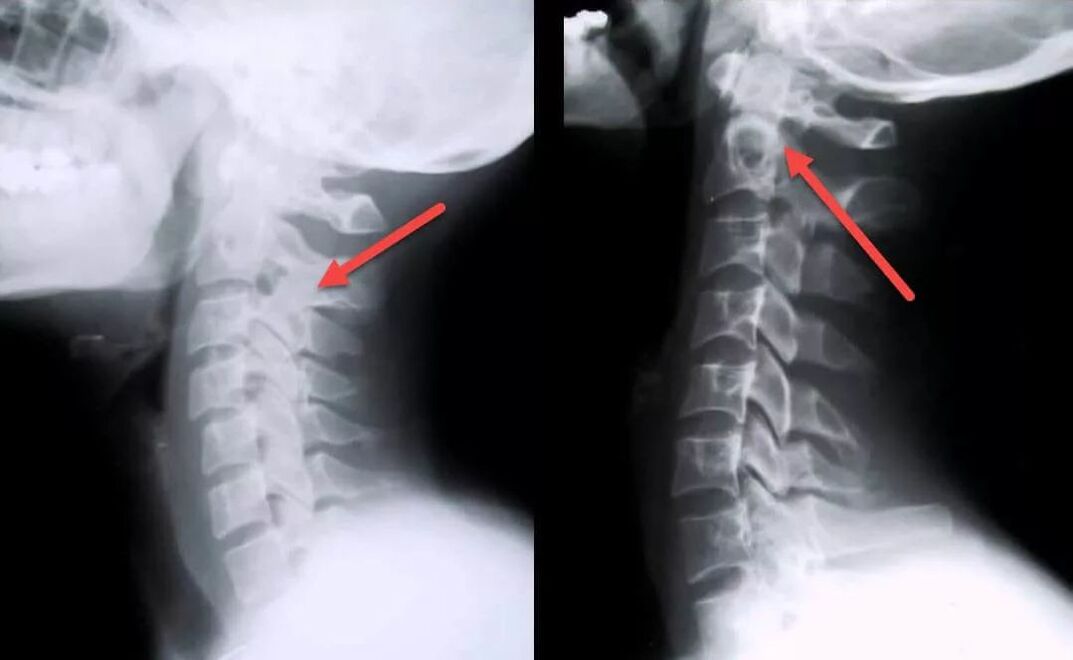
Cervical osteochondrosis is a chronic disease caused by degenerative changes in the intervertebral discs of the neck. As the disease progresses, surrounding structures become involved in the pathological process, which causes the development of a series of unpleasant symptoms. Treatment of the disease is complex, conservative and includes the use of medications and non-drug methods.
Causes
The exact reasons are unknown. The theory that the development of the disease is associated with age-related changes has not been confirmed, as today this pathology is diagnosed even in adolescents.
Factors that can trigger the development of the disease include:
- low physical activity, sedentary lifestyle;
- mechanical injuries to the neck;
- sedentary work with high static load on the cervical spine;
- uncomfortable mattresses and pillows;
- obesity;
- circulatory disorders;
- scoliosis and other postural defects;
- connective tissue dysplasia;
- metabolic disorders.
Syndromes and symptoms

Symptoms of cervical osteochondrosis do not appear immediately. For a long time, the disease can progress asymptomatically or disguise itself as other pathologies. The most common signs of cervical osteochondrosis are:
- tinnitus - usually occurs when changing position after a long stay in a stationary position;
- dizziness - the patient periodically feels as if objects begin to rotate before his eyes;
- pain in the neck, back of the head - the intensity of the pain depends on the degree of pathological changes;
- feeling of shortness of breath - the patient cannot take a deep breath;
- visual impairment - occurs in later stages;
- nausea, vomiting - are also associated with impaired blood supply to certain parts of the brain due to compression of main arteries by deformed discs;
- sore throat, dry throat, foreign body sensation;
- pressure changes poorly controlled by medication;
- numbness of the fingers;
- pain in the shoulder.
In addition to general clinical signs, there are several characteristic syndromes:
Vertebral:
- pain when turning the neck;
- impaired mobility;
- X-rays show signs of damage to the vertebrae and discs.
Cardiac:
- burning and pain in the chest;
- increased fatigue, causeless weakness;
- tachycardia.
Vertebral artery. This syndrome occurs as a result of narrowing of the vertebral artery, which supplies blood to the brain. Manifested by tinnitus, dizziness and blurred vision.
Koreshkovy. It occurs due to compression or compression of the nerve roots exiting the cervical spine.
Stages
Stages of the disease:
- The patient feels slight discomfort in the neck area. The intervertebral discs begin to lose stability.
- The pain appears. The discs become deformed, the destruction of the fibrous ring begins and the vertebrae become closer to each other.
- Neck movements are limited. When turning the head, nausea and dizziness may occur. The constant lack of blood in the brain leads to symptoms such as lethargy, weakness, decreased performance and fatigue. The discs become thinner, the vertebrae begin to rub against each other, the fibrous ring is destroyed and intervertebral hernias form.
- The neck area is immobilized, the blood supply to the brain is completely stopped. To correct this condition, the patient must constantly take special medications. The vertebrae begin to fuse.
Diagnosis

Diagnosis can be difficult due to the nonspecific clinical picture and the great variability of possible symptoms. The patient may need the help of several specialists at once (surgeon, neurologist, cardiologist, vertebrologist, orthopedist and others).
During the consultation, the doctor listens to the patient's complaints, takes anamnesis, performs an examination and makes a preliminary diagnosis.
To confirm it, the following may be prescribed:
- blood analysis;
- Magnetic resonance imaging of the neck - allows you to identify pathological changes even at the initial stage of the disease, when clinical manifestations are not yet very pronounced; with the help of this study you can assess the current state of the vertebrae, discs, identify the presence of deformations, osteophytes, compression of nerves and blood vessels;
- Dopplerography of the cervical arteries - allows you to assess the degree of compression and damage to blood vessels, the speed of blood flow;
- myelography with contrast - allows you to identify compressed nerves;
- ECG - carried out for differential diagnosis with cardiovascular diseases.
Treatment
Drug therapy includes taking the following groups of medications:
- Ines. Effectively relieves inflammation, pain and swelling. These are means of symptomatic therapy that do not affect the causes of the disease. NSAIDs can be used in short courses of 10 to 14 days.
- Angioprotectors, means accelerating blood flow. Improves cerebral circulation, protects blood vessels from damage.
- Glucocorticosteroids. Effectively relieves pain and nerve compression. Medicines in this group have many side effects and should only be taken as prescribed by a doctor if NSAIDs and pain relievers do not help.
- Chondroprotectors. Improves the health of intervertebral discs, influencing the causes of the disease. They inhibit the destruction of cartilaginous tissue and improve the shock-absorbing properties of the discs.
Non-drug treatment may include the use of the following techniques:
- Exercise therapy. Regular training strengthens muscles and relieves spasms. Classes (at least at the initial stage) are recommended to be carried out under the guidance of a specialist
- Manual therapy. Muscle spasms in the neck are one of the main causes of pain in this disease. Correctly performed manual therapy helps eliminate spasms, compression of blood vessels and nerves. As a result, the nutrition of the discs improves, cerebral circulation is normalized and the pain disappears.
- Kinésio recording. The application of special tapes relaxes the muscles, relieves spasms, swelling, inflammation and at the same time keeps the spine in a physiologically correct position.
- Orthopedic devices. To minimize the load on the cervical spine, it is recommended to use orthopedic mattresses and pillows for sleeping. Also, some patients are advised to wear a special device (Schanz collar), which fixes the neck in the correct position.
- Massage. An effective remedy against the cervical form of the disease. Perfectly relieves swelling, pain, congestion, improves local blood circulation, relieves muscle spasms. Do not massage if you have acute neck pain.
- Physiotherapy. Another effective technique. Sessions are held in courses several times a year. This allows you to get rid of unpleasant symptoms, relieve muscle spasms and slow down the progression of the disease. For the treatment of cervical osteochondrosis, laser therapy, magnetic therapy, mechanotherapy, traction therapy, hydromassage, UVT and mud therapy are most often used.
If conservative therapy does not produce results and the disease continues to progress, surgical treatment may be prescribed.
- operations to remove intervertebral hernias;
- removal of the vertebral arch or spinous processes leads to decompression of the spinal cord roots;
- removing part of the disc nucleus to repair a hernia.
The decision on how to treat the disease is made by the doctor individually for each patient. Self-medication is prohibited and can lead to the development of various complications.
Complications

If the disease is neglected, the following complications may occur:
- VSD;
- lack of oxygen to the brain;
- arterial hypertension;
- blurred vision, retinal dystrophy;
- respiratory spasm;
- violation of the act of swallowing due to esophageal dysfunction;
- thyroid gland dysfunction;
- cramps and numbness in the neck muscles;
- chronic pain in the upper body that is not relieved by painkillers;
- hormonal imbalances.
Prevention
To minimize the risk of developing the disease, you must follow the following recommendations:
- maintain posture;
- properly equip the workplace so that neck strain does not occur;
- Healthy food;
- stop smoking and drinking alcohol;
- avoid neck injuries;
- move more, exercise;
- do not overcool;
- control weight;
- sleep on a special orthopedic mattress and pillow;
- do gymnastics regularly to avoid the development of congestion;
- prevent curvature of the spine;
- regularly take massage courses to improve blood flow and relieve congestion;
- do not sit for a long time with your head tilted forward;
- If you feel discomfort in the neck area, you need to make an appointment with a specialist and undergo an examination, this will help to identify possible changes in the discs early, which will greatly facilitate treatment and improve the prognosis.






















